Unfolding Mechanism and Fibril Formation Propensity of Human Prion Protein in the Presence of Molecular Crowding Agents
Abstract
:1. Introduction
2. Results
2.1. CD Spectroscopy
2.2. NMR Structural Investigation of HuPrP(90–231) in the Presence of Ficoll-70
2.3. NMR Thermal Unfolding Characterization
2.4. ThT Fibrillation Experiments
3. Discussion
4. Materials and Methods
4.1. Materials
4.2. CD Spectroscopy
4.3. NMR Experiments
4.4. NMR Chemical Shifts and Thermal Analysis
4.5. Aggregation Assay
5. Conclusions
Author Contributions
Funding
Institutional Review Board Statement
Informed Consent Statement
Data Availability Statement
Conflicts of Interest
References
- Baldwin, K.J.; Correll, C.M. Prion Disease. Semin. Neurol. 2019, 39, 428–439. [Google Scholar] [CrossRef] [PubMed]
- Rossi, M.; Baiardi, S.; Parchi, P. Understanding Prion Strains: Evidence from Studies of the Disease Forms Affecting Humans. Viruses 2019, 11, 309. [Google Scholar] [CrossRef] [PubMed]
- Horwich, A.L.; Weissman, J.S. Deadly Conformations—Protein Misfolding in Prion Disease. Cell 1997, 89, 499–510. [Google Scholar] [CrossRef] [PubMed]
- Weissmann, C. Molecular biology of transmissible spongiform encephalopathies. FEBS Lett. 1996, 389, 3–11. [Google Scholar] [CrossRef] [PubMed]
- Prusiner, S.B. Prion Diseases and the BSE Crisis. Science 1997, 278, 245–251. [Google Scholar] [CrossRef]
- Prusiner, S.B. (Ed.) Human Prion Diseases and Neurodegeneration. In Prions Prions Prions; Springer: Berlin/Heidelberg, Germany, 1996; Volume 207, pp. 1–17. [Google Scholar]
- Zhu, C.; Aguzzi, A. Prion protein and prion disease at a glance. J. Cell Sci. 2021, 134, jcs245605. [Google Scholar] [CrossRef]
- Prusiner, S.B. Prions. Proc. Natl. Acad. Sci. USA 1998, 95, 13363–13383. [Google Scholar] [CrossRef]
- Atkinson, C.J.; Zhang, K.; Munn, A.L.; Wiegmans, A.; Wei, M.Q. Prion protein scrapie and the normal cellular prion protein. Prion 2016, 10, 63–82. [Google Scholar] [CrossRef]
- Basler, K.; Oesch, B.; Scott, M.; Westaway, D.; Wälchli, M.; Groth, D.; McKinley, M.; Prusiner, S.; Weissmann, C. Scrapie and cellular PrP isoforms are encoded by the same chromosomal gene. Cell 1986, 46, 417–428. [Google Scholar] [CrossRef]
- Hsiao, K.; Baker, H.F.; Crow, T.J.; Poulter, M.; Owen, F.; Terwilliger, J.D.; Westaway, D.; Ott, J.; Prusiner, S.B. Linkage of a prion protein missense variant to Gerstmann–Sträussler syndrome. Nature 1989, 338, 342–345. [Google Scholar] [CrossRef]
- Appleby, B.S.; Shetty, S.; Elkasaby, M. Genetic aspects of human prion diseases. Front. Neurol. 2022, 13, 1003056. [Google Scholar] [CrossRef] [PubMed]
- Takada, L.; Geschwind, M. Prion Diseases. Semin. Neurol. 2013, 33, 348–356. [Google Scholar] [CrossRef] [PubMed]
- Scott, M.R.; Will, R.; Ironside, J.; Nguyen, H.-O.B.; Tremblay, P.; DeArmond, S.J.; Prusiner, S.B. Compelling transgenetic evidence for transmission of bovine spongiform encephalopathy prions to humans. Proc. Natl. Acad. Sci. USA 1999, 96, 15137–15142. [Google Scholar] [CrossRef] [PubMed]
- Bruce, M.E.; Will, R.G.; Ironside, J.W.; McConnell, I.; Drummond, D.; Suttie, A.; McCardle, L.; Chree, A.; Hope, J.; Birkett, C.; et al. Transmissions to mice indicate that ‘new variant’ CJD is caused by the BSE agent. Nature 1997, 389, 498–501. [Google Scholar] [CrossRef] [PubMed]
- Steele, A.D.; Emsley, J.G.; Özdinler, P.H.; Lindquist, S.; Macklis, J.D. Prion protein (PrPc) positively regulates neural precursor proliferation during developmental and adult mammalian neurogenesis. Proc. Natl. Acad. Sci. USA 2006, 103, 3416–3421. [Google Scholar] [CrossRef]
- Mouillet-Richard, S.; Ermonval, M.; Chebassier, C.; Laplanche, J.L.; Lehmann, S.; Launay, J.M.; Kellermann, O. Signal Transduction Through Prion Protein. Science 2000, 289, 1925–1928. [Google Scholar] [CrossRef]
- Lewis, V. The role of lipid rafts in prion protein biology. Front. Biosci. 2011, 16, 151. [Google Scholar] [CrossRef]
- Bounhar, Y.; Zhang, Y.; Goodyer, C.G.; LeBlanc, A. Prion Protein Protects Human Neurons against Bax-mediated Apoptosis. J. Biol. Chem. 2001, 276, 39145–39149. [Google Scholar] [CrossRef]
- Roucou, X.; Giannopoulos, P.N.; Zhang, Y.; Jodoin, J.; Goodyer, C.G.; LeBlanc, A. Cellular prion protein inhibits proapoptotic Bax conformational change in human neurons and in breast carcinoma MCF-7 cells. Cell Death Differ. 2005, 12, 783–795. [Google Scholar] [CrossRef]
- Schmitt-Ulms, G.; Legname, G.; Baldwin, M.A.; Ball, H.L.; Bradon, N.; Bosque, P.J.; Crossin, K.L.; Edelman, G.M.; DeArmond, S.J.; Cohen, F.E.; et al. Binding of neural cell adhesion molecules (N-CAMs) to the cellular prion protein. J. Mol. Biol. 2001, 314, 1209–1225. [Google Scholar] [CrossRef]
- Miranzadeh Mahabadi, H.; Taghibiglou, C. Cellular Prion Protein (PrPc): Putative Interacting Partners and Consequences of the Interaction. Int. J. Mol. Sci. 2020, 21, 7058. [Google Scholar] [CrossRef] [PubMed]
- Millhauser, G.L. Copper and the Prion Protein: Methods, Structures, Function, and Disease. Annu. Rev. Phys. Chem. 2007, 58, 299–320. [Google Scholar] [CrossRef] [PubMed]
- Zahn, R.; Liu, A.; Lührs, T.; Riek, R.; von Schroetter, C.; García, F.L.; Billeter, M.; Calzolai, L.; Wider, G.; Wüthrich, K. NMR solution structure of the human prion protein. Proc. Natl. Acad. Sci. USA 2000, 97, 145–150. [Google Scholar] [CrossRef] [PubMed]
- Riek, R.; Hornemann, S.; Wider, G.; Billeter, M.; Glockshuber, R.; Wüthrich, K. NMR structure of the mouse prion protein domain PrP(121–231). Nature 1996, 382, 180–182. [Google Scholar] [CrossRef] [PubMed]
- James, T.L.; Liu, H.; Ulyanov, N.B.; Farr-Jones, S.; Zhang, H.; Donne, D.G.; Kaneko, K.; Groth, D.; Mehlhorn, I.; Prusiner, S.B.; et al. Solution structure of a 142-residue recombinant prion protein corresponding to the infectious fragment of the scrapie isoform. Proc. Natl. Acad. Sci. USA 1997, 94, 10086–10091. [Google Scholar] [CrossRef] [PubMed]
- Abskharon, R.; Wang, F.; Wohlkonig, A.; Ruan, J.; Soror, S.; Giachin, G.; Pardon, E.; Zou, W.; Legname, G.; Ma, J.; et al. Structural evidence for the critical role of the prion protein hydrophobic region in forming an infectious prion. PLoS Pathog. 2019, 15, e1008139. [Google Scholar] [CrossRef]
- Kuwata, K.; Matumoto, T.; Cheng, H.; Nagayama, K.; James, T.L.; Roder, H. NMR-detected hydrogen exchange and molecular dynamics simulations provide structural insight into fibril formation of prion protein fragment 106–126. Proc. Natl. Acad. Sci. USA 2003, 100, 14790–14795. [Google Scholar] [CrossRef]
- Ning, L.; Guo, J.; Jin, N.; Liu, H.; Yao, X. The role of Cys179–Cys214 disulfide bond in the stability and folding of prion protein: Insights from molecular dynamics simulations. J. Mol. Model. 2014, 20, 2106. [Google Scholar]
- Apetri, A.C.; Surewicz, K.; Surewicz, W.K. The Effect of Disease-associated Mutations on the Folding Pathway of Human Prion Protein. J. Biol. Chem. 2004, 279, 18008–18014. [Google Scholar] [CrossRef]
- Apetri, A.C.; Maki, K.; Roder, H.; Surewicz, W.K. Early Intermediate in Human Prion Protein Folding As Evidenced by Ultrarapid Mixing Experiments. J. Am. Chem. Soc. 2006, 128, 11673–11678. [Google Scholar] [CrossRef]
- Hart, T.; Hosszu, L.L.P.; Trevitt, C.R.; Jackson, G.S.; Waltho, J.P.; Collinge, J.; Clarke, A.R. Folding kinetics of the human prion protein probed by temperature jump. Proc. Natl. Acad. Sci. USA 2009, 106, 5651–5656. [Google Scholar] [CrossRef] [PubMed]
- Russo, L.; Salzano, G.; Corvino, A.; Bistaffa, E.; Moda, F.; Celauro, L.; D’Abrosca, G.; Isernia, C.; Milardi, D.; Giachin, G.; et al. Structural and dynamical determinants of a β-sheet-enriched intermediate involved in amyloid fibrillar assembly of human prion protein. Chem. Sci. 2022, 13, 10406–10427. [Google Scholar] [CrossRef] [PubMed]
- Ghosh, S.; Prabhu, N.P. Heterogeneous Macromolecular crowding effect on nucleation-independent fibril formation of Lysozyme: Spectroscopic analysis of Structure, Stability, and fibrillation rate. Spectrochim. Acta Part A Mol. Biomol. Spectrosc. 2024, 315, 124276. [Google Scholar] [CrossRef] [PubMed]
- Zazeri, G.; Povinelli AP, R.; Pavan, N.M.; Jones, A.M.; Ximenes, V.F. Solvent-Induced Lag Phase during the Formation of Lysozyme Amyloid Fibrils Triggered by Sodium Dodecyl Sulfate: Biophysical Experimental and In Silico Study of Solvent Effects. Molecules 2023, 28, 6891. [Google Scholar] [CrossRef] [PubMed]
- Prusiner, S. Prion Biology and Diseases; Cold Spring Harbor Laboratory Press: Cold Spring Harbor, NY, USA, 1999. [Google Scholar]
- Sanz-Hernández, M.; Barritt, J.D.; Sobek, J.; Hornemann, S.; Aguzzi, A.; De Simone, A. Mechanism of misfolding of the human prion protein revealed by a pathological mutation. Proc. Natl. Acad. Sci. USA 2021, 118, e2019631118. [Google Scholar] [CrossRef]
- Kupfer, L.; Hinrichs, W.; Groschup, M. Prion Protein Misfolding. Curr. Mol. Med. 2009, 9, 826–835. [Google Scholar] [CrossRef]
- Noinville, S.; Chich, J.-F.; Rezaei, H. Misfolding of the prion protein: Linking biophysical and biological approaches. Vet. Res. 2008, 39, 48. [Google Scholar] [CrossRef]
- Fontaine, S.; Brown, D. Mechanisms of Prion Protein Aggregation. Protein Pept. Lett. 2009, 16, 14–26. [Google Scholar] [CrossRef]
- Watanabe, Y.; Inanami, O.; Horiuchi, M.; Hiraoka, W.; Shimoyama, Y.; Inagaki, F.; Kuwabara, M. Identification of pH-sensitive regions in the mouse prion by the cysteine-scanning spin-labeling ESR technique. Biochem. Biophys. Res. Commun. 2006, 350, 549–556. [Google Scholar] [CrossRef]
- Wang, Y.; He, H.; Li, S. Effect of Ficoll 70 on thermal stability and structure of creatine kinase. Biochemistry 2010, 75, 648–654. [Google Scholar] [CrossRef]
- Cardoso NB, S.; Esteves, M.B.; Bonafe CF, S.; Paulillo LC, M.S.; Bispo JA, C. Thermodynamic and kinetic modeling of the protection of mammalian cells against ethanol-induced damage by extracts of Jatropha curcas (Euphorbiaceae). Eng. Rep. 2019, 1, e12077. [Google Scholar] [CrossRef]
- Hong, J.; Gierasch, L.M. Macromolecular Crowding Remodels the Energy Landscape of a Protein by Favoring a More Compact Unfolded State. J. Am. Chem. Soc. 2010, 132, 10445–10452. [Google Scholar] [CrossRef] [PubMed]
- Xue, C.; Lin, T.Y.; Chang, D.; Guo, Z. Thioflavin T as an amyloid dye: Fibril quantification, optimal concentration and effect on aggregation. R. Soc. Open Sci. 2017, 4, 160696. [Google Scholar] [CrossRef] [PubMed]
- Grzesiek, S.; Doebeli, H.; Gentz, R.; Garotta, G.; Labhardt, A.M.; Bax, A. Proton, carbon-13, and nitrogen-15 NMR backbone assignments and secondary structure of human interferon-gamma. Biochemistry 1992, 31, 8180–8190. [Google Scholar] [CrossRef]
- Delaglio, F.; Grzesiek, S.; Vuister, G.W.; Zhu, G.; Pfeifer, J.; Bax, A. NMRPipe: A multidimensional spectral processing system based on UNIX pipes. J. Biomol. NMR 1995, 6, 277–293. [Google Scholar] [CrossRef]
- Lee, W.; Tonelli, M.; Markley, J.L. NMRFAM-SPARKY: Enhanced software for biomolecular NMR spectroscopy. Bioinformatics 2015, 31, 1325–1327. [Google Scholar] [CrossRef]
- Keller, R. Optimizing the Process of Nuclear Magnetic Resonance Spectrum Analysis and Computer Aided Resonance Assignment. Ph.D. Thesis, Swiss Federal Institute of Technology Zurich, Switzerland, 2005. [Google Scholar]
- Silva, J.L.; Vieira, T.C.; Cordeiro, Y.; De Oliveira GA, P. Nucleic acid actions on abnormal protein aggregation, phase transitions and phase separation. Curr. Opin. Struct. Biol. 2022, 73, 102346. [Google Scholar] [CrossRef]
- Kamps, J.; Bader, V.; Winklhofer, K.F.; Tatzelt, J. Liquid–liquid phase separation of the prion protein is regulated by the octarepeat domain independently of histidines and copper. J. Biol. Chem. 2024, 300, 107310. [Google Scholar] [CrossRef]
- Pettersen, E.F.; Goddard, T.D.; Huang, C.C.; Couch, G.S.; Greenblatt, D.M.; Meng, E.C.; Ferrin, T.E. UCSF Chimera—A visualization system for exploratory research and analysis. J. Comput. Chem. 2004, 25, 1605–1612. [Google Scholar] [CrossRef]
- Alfano, C.; Fichou, Y.; Huber, K.; Weiss, M.; Spruijt, E.; Ebbinghaus, S.; De Luca, G.; Morando, M.A.; Vetri, V.; Temussi, P.A.; et al. Molecular Crowding: The History and Development of a Scientific Paradigm. Chem. Rev. 2024, 124, 3186–3219. [Google Scholar] [CrossRef]
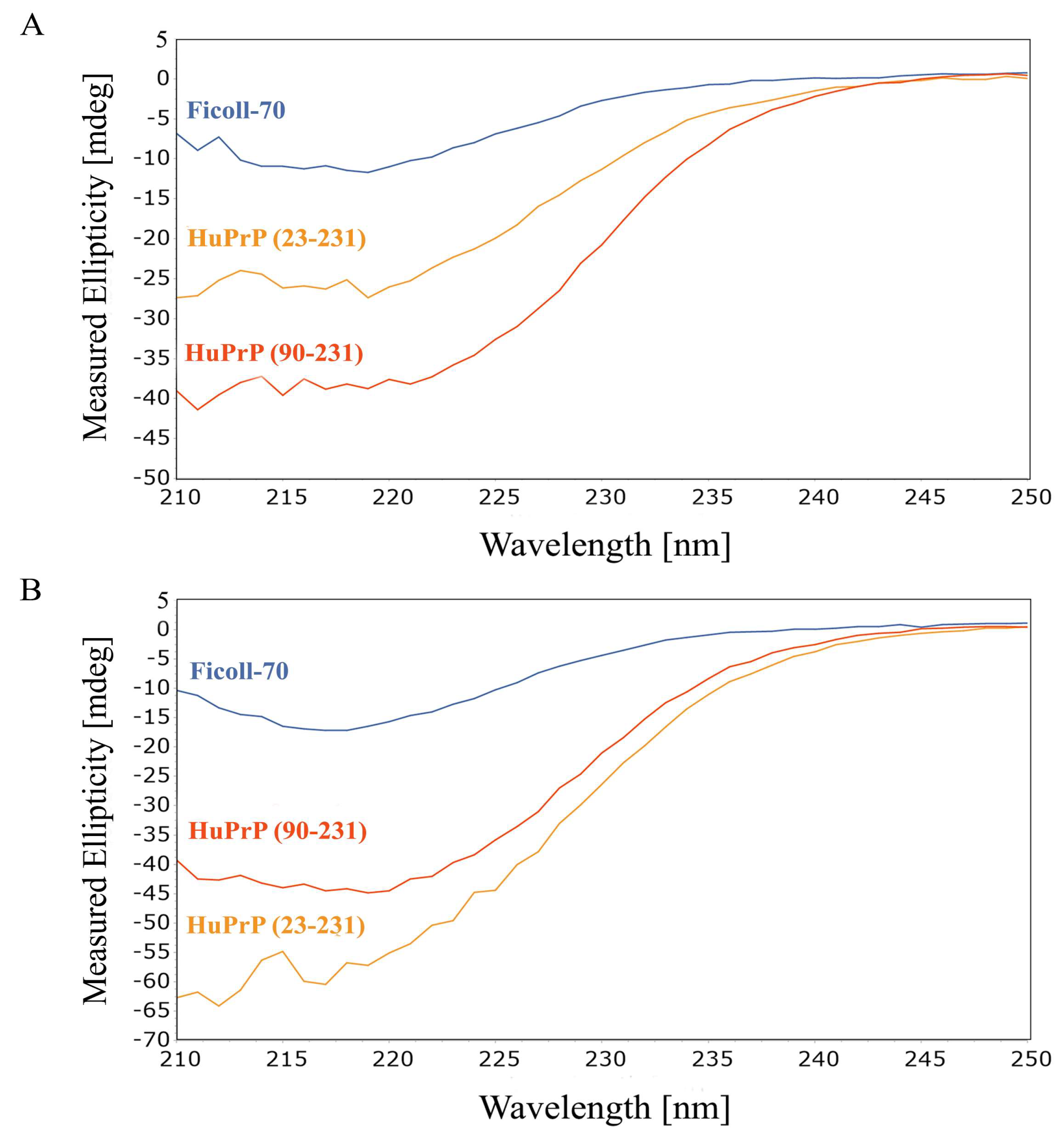
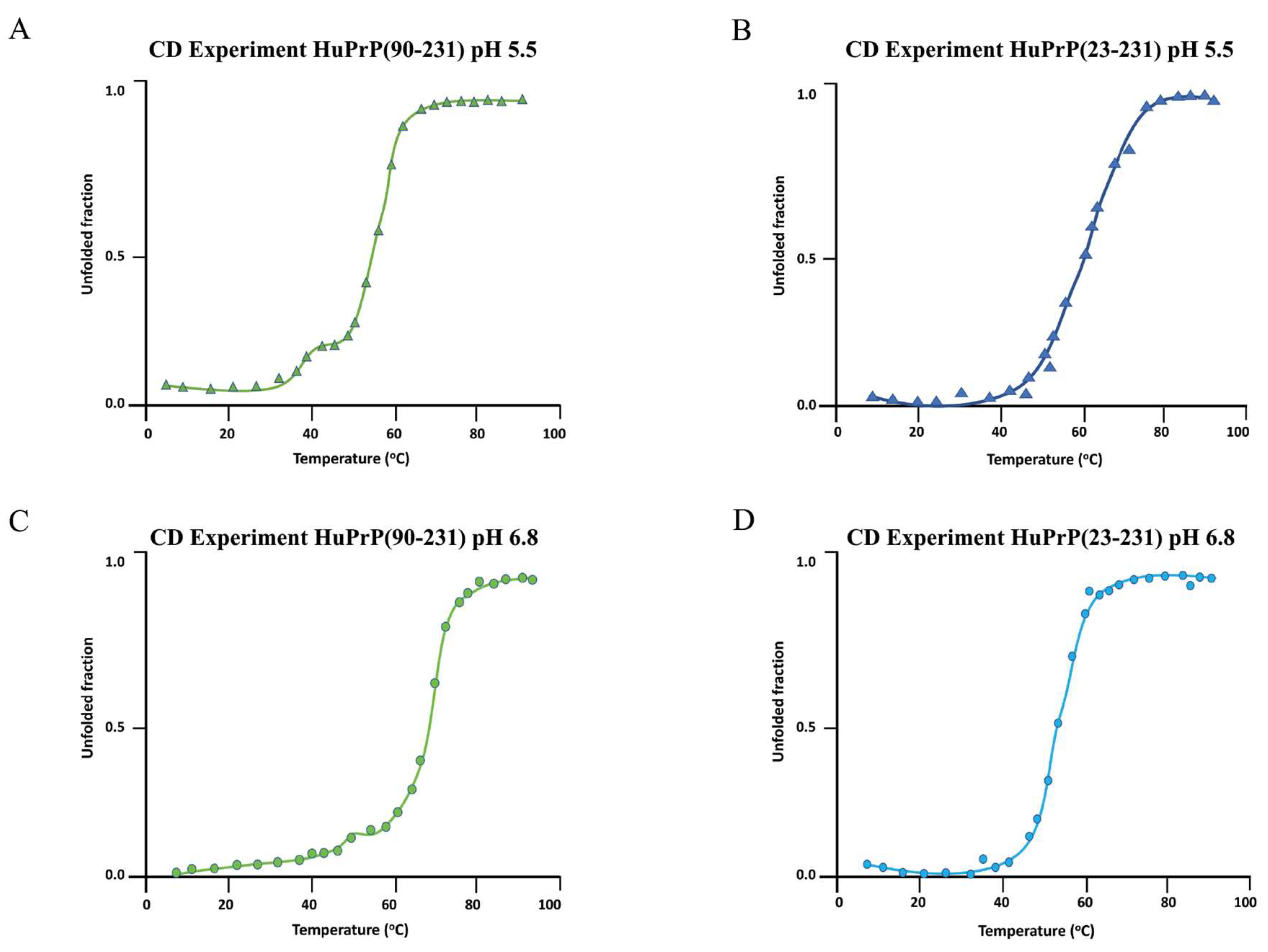
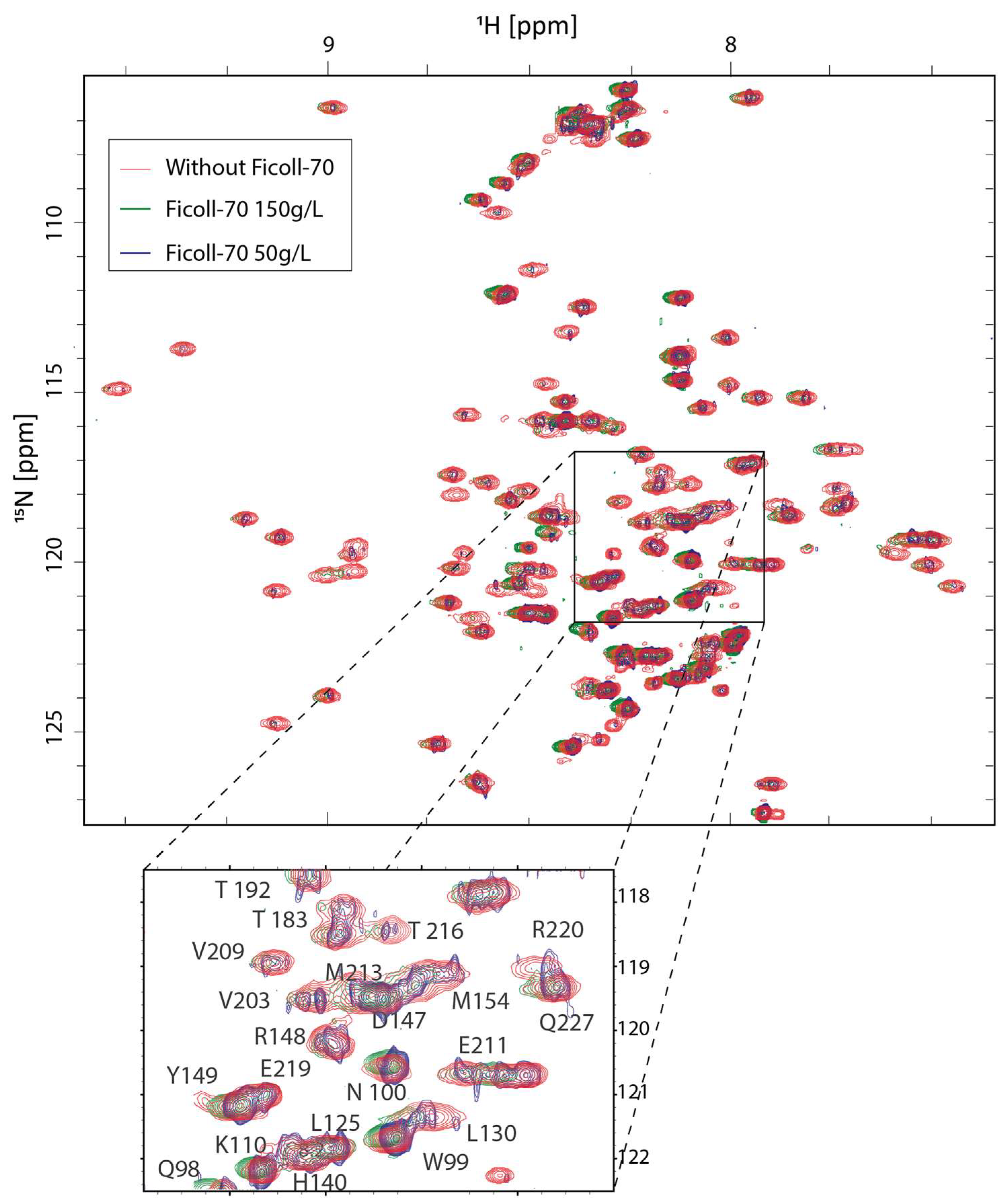
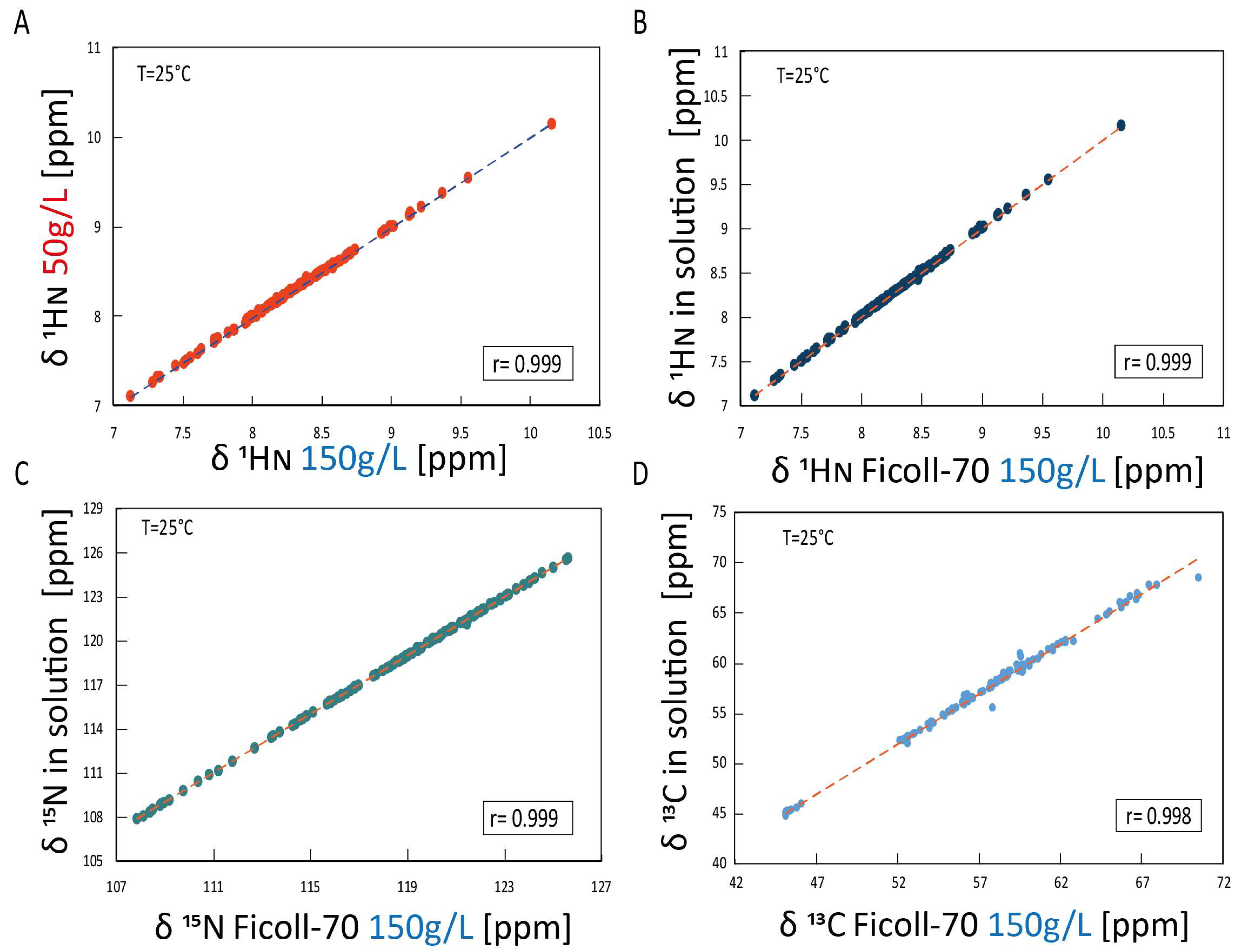
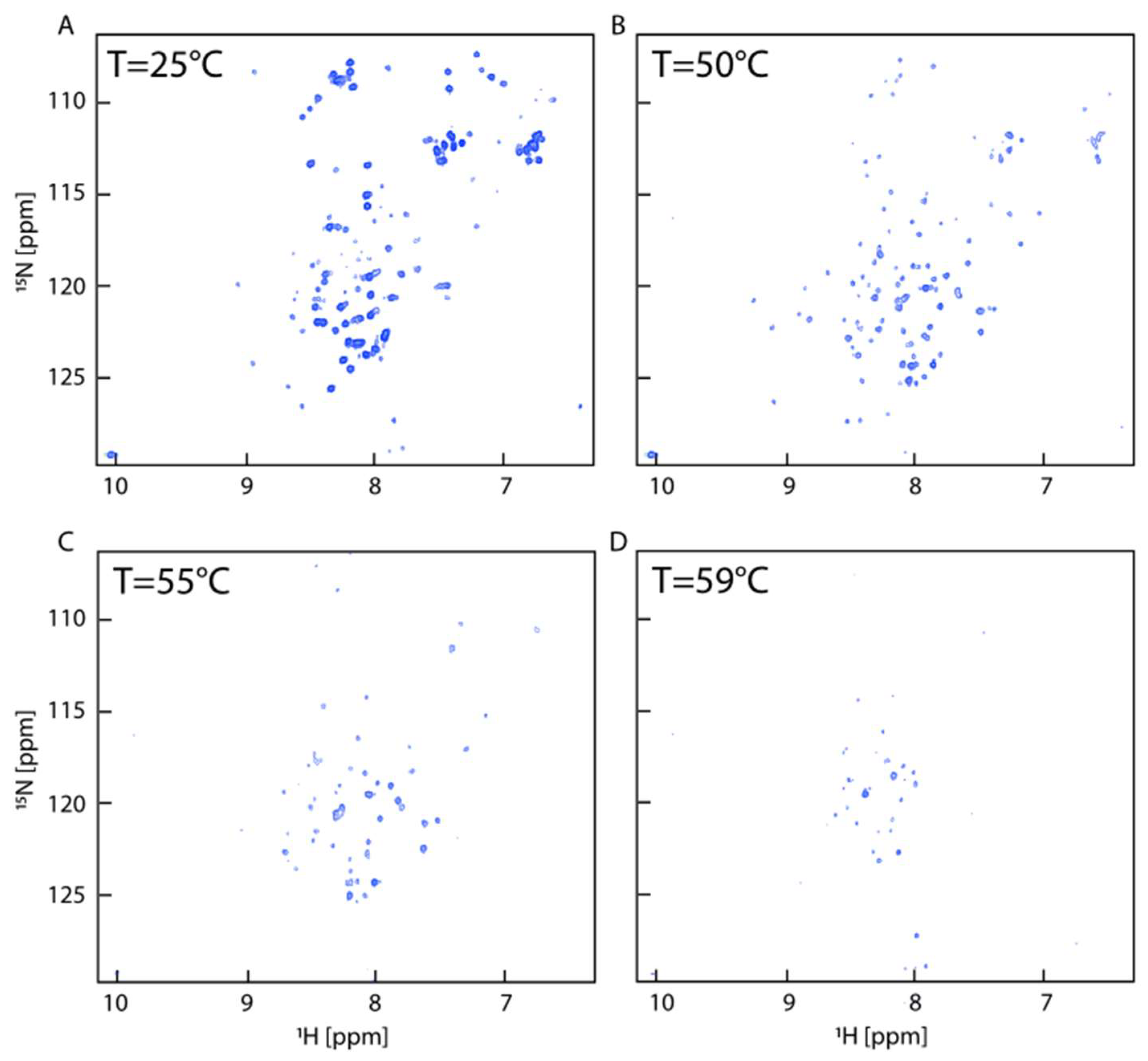
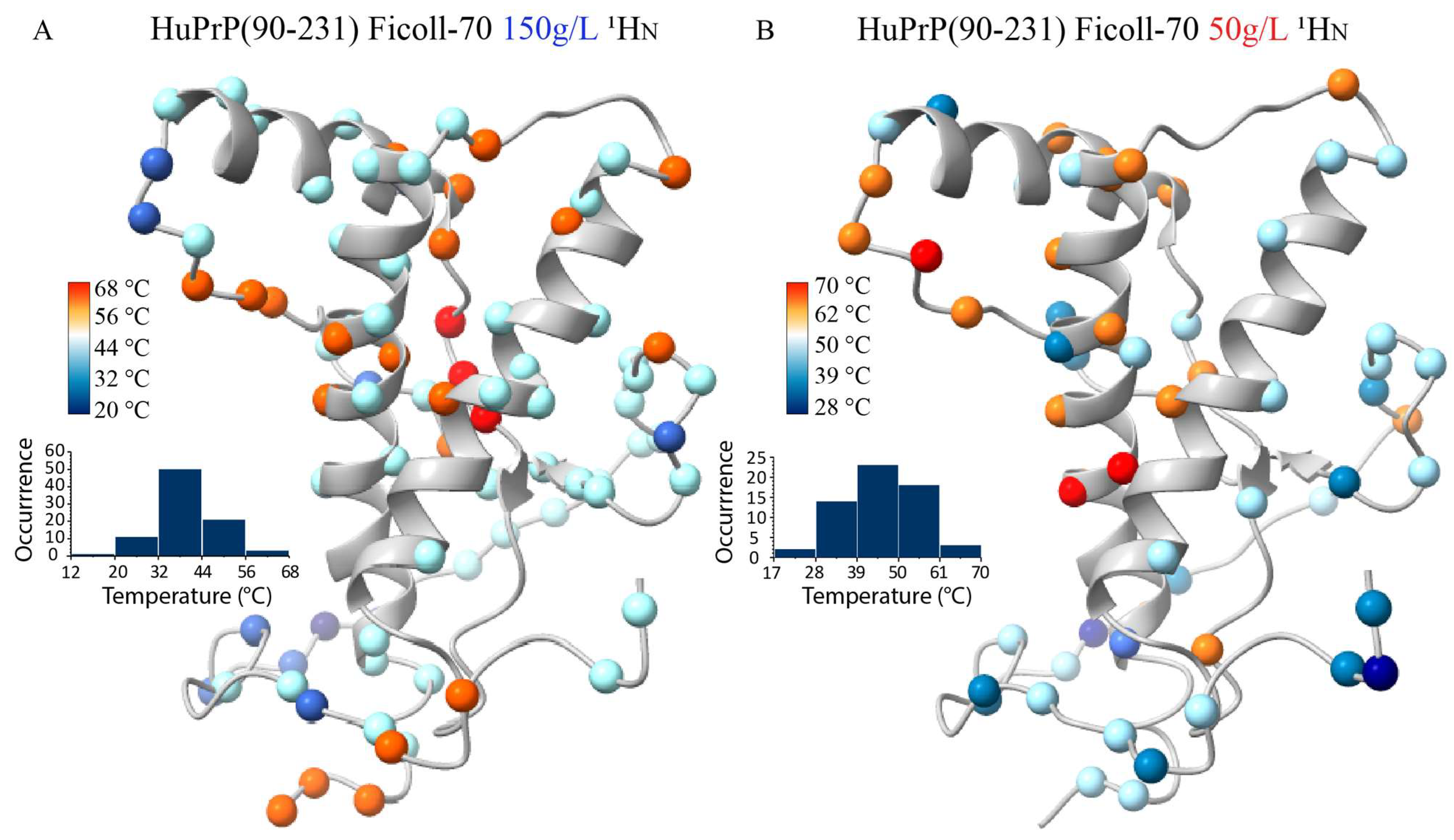
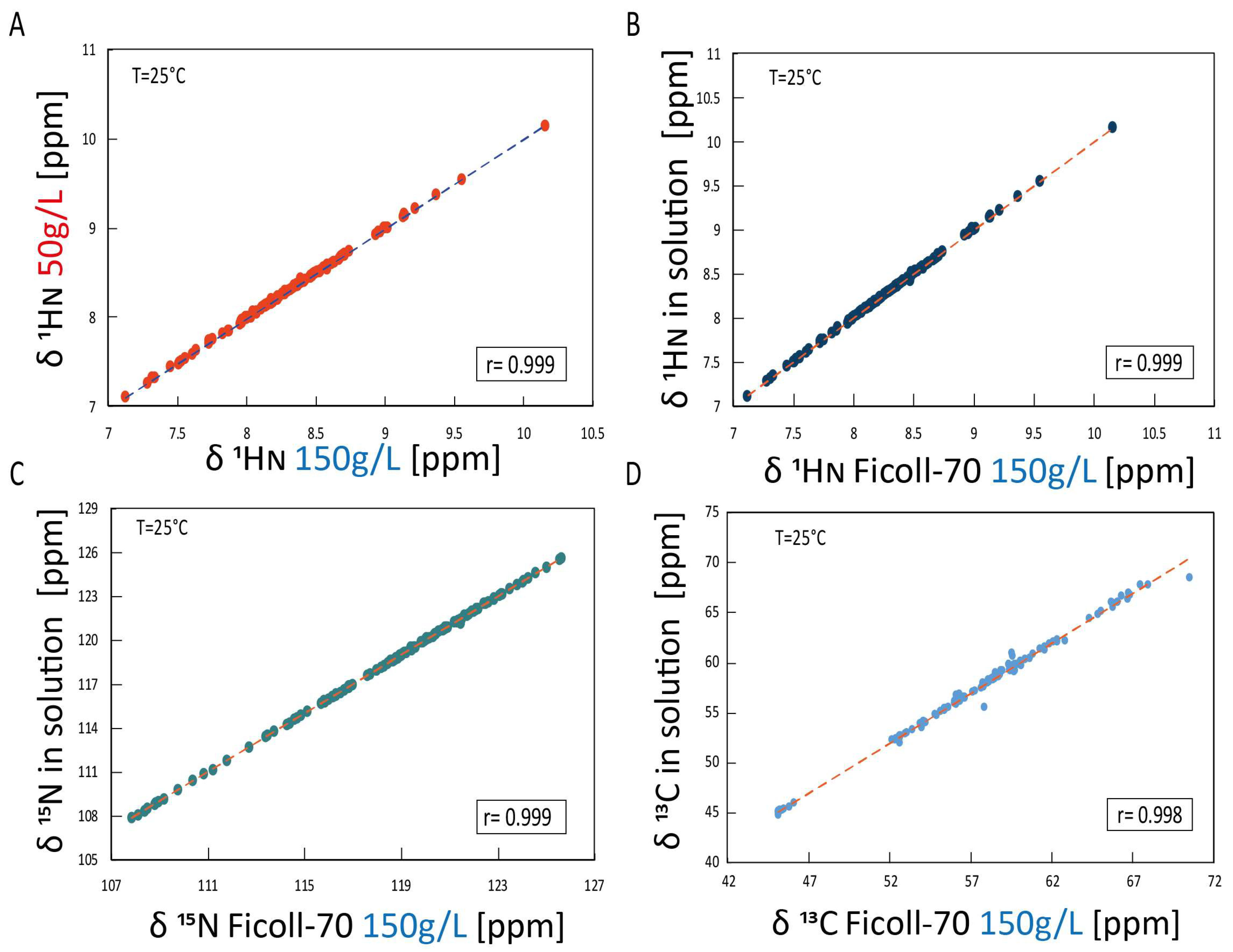
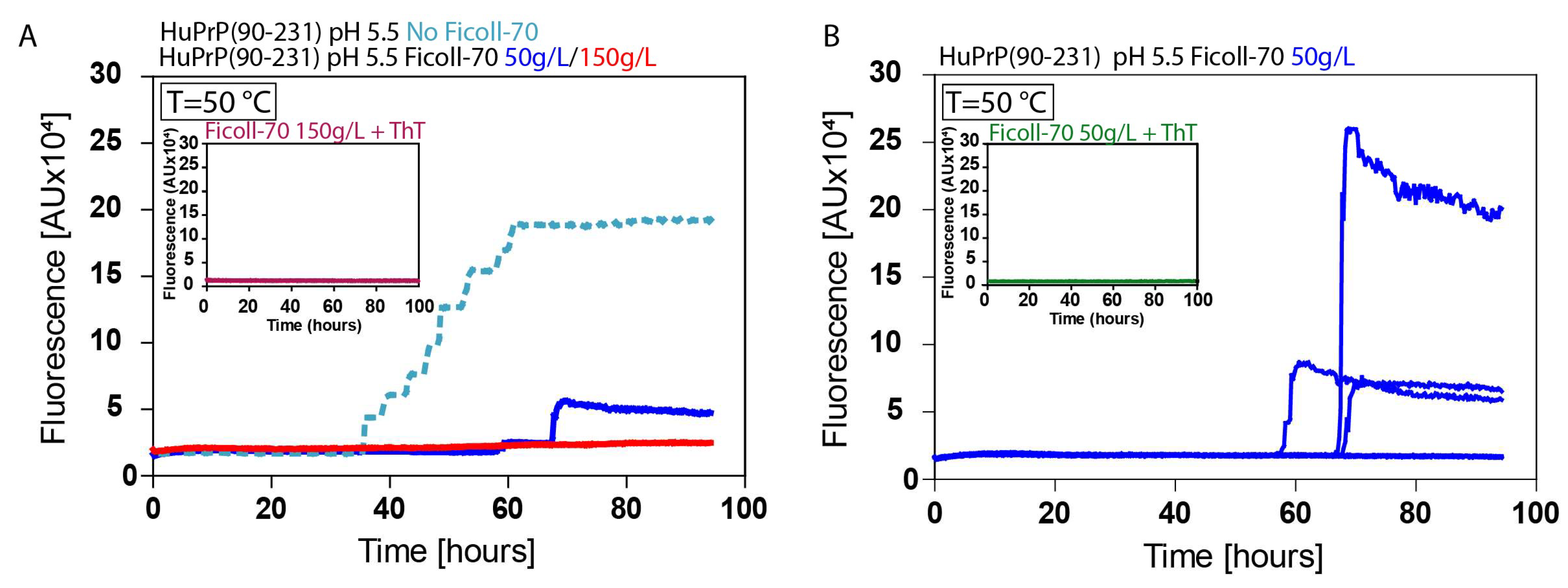
| Protein | Condition | Tm1 (°C) | Tm2 (°C) |
|---|---|---|---|
| HuPrP(90–231) | Ficoll-70 pH 5.5 | 41 ± 2 | 54 ± 2 |
| Buffer solution pH 5.5 | 55 ± 1 * | 72 ± 1 * | |
| HuPrP(23–231) | Ficoll-70 pH 5.5 | - | 59 ± 3 |
| Buffer solution pH 5.5 | - | 69 ± 3 * | |
| HuPrP(90–231) | Ficoll-70 pH 6.8 | 50 ± 2 | 66 ± 2 |
| Buffer solution pH 6.8 | 59 ± 3 * | 68 ± 2 * | |
| HuPrP(23–231) | Ficoll-70 pH 6.8 | - | 53 ± 4 |
| Buffer solution pH 6.8 | - | 59 ± 1 * |
Disclaimer/Publisher’s Note: The statements, opinions and data contained in all publications are solely those of the individual author(s) and contributor(s) and not of MDPI and/or the editor(s). MDPI and/or the editor(s) disclaim responsibility for any injury to people or property resulting from any ideas, methods, instructions or products referred to in the content. |
© 2024 by the authors. Licensee MDPI, Basel, Switzerland. This article is an open access article distributed under the terms and conditions of the Creative Commons Attribution (CC BY) license (https://creativecommons.org/licenses/by/4.0/).
Share and Cite
Madheswaran, M.; Ventserova, N.; D’Abrosca, G.; Salzano, G.; Celauro, L.; Cazzaniga, F.A.; Isernia, C.; Malgieri, G.; Moda, F.; Russo, L.; et al. Unfolding Mechanism and Fibril Formation Propensity of Human Prion Protein in the Presence of Molecular Crowding Agents. Int. J. Mol. Sci. 2024, 25, 9916. https://doi.org/10.3390/ijms25189916
Madheswaran M, Ventserova N, D’Abrosca G, Salzano G, Celauro L, Cazzaniga FA, Isernia C, Malgieri G, Moda F, Russo L, et al. Unfolding Mechanism and Fibril Formation Propensity of Human Prion Protein in the Presence of Molecular Crowding Agents. International Journal of Molecular Sciences. 2024; 25(18):9916. https://doi.org/10.3390/ijms25189916
Chicago/Turabian StyleMadheswaran, Manoj, Nataliia Ventserova, Gianluca D’Abrosca, Giulia Salzano, Luigi Celauro, Federico Angelo Cazzaniga, Carla Isernia, Gaetano Malgieri, Fabio Moda, Luigi Russo, and et al. 2024. "Unfolding Mechanism and Fibril Formation Propensity of Human Prion Protein in the Presence of Molecular Crowding Agents" International Journal of Molecular Sciences 25, no. 18: 9916. https://doi.org/10.3390/ijms25189916








